Tools for injection molding may be hard to design or manufacture. However, they have basic concepts which are easy to understand. An injection molding gate system helps to direct the molten plastic from the nozzles of molding machines. This is a gateway of the plastic into the core of the tool.
When the injection molding gate design is not right, there may be potential defects in the plastic parts. These injection molding defects affect the integrity of the component. A gate design with the wrong size, dimensions, or location will affect the manufacturing process.
Therefore, every product developer should understand the details of injection molding gate design. The information in this guide will help you make the best decisions for your injection molding parts.
Importance of Injection Molding Gate Design
Gates have direct influences on the result of a plastic injection molding process. An adequately designed gate controls the direction and volume of the molten plastic that flows into the mold. You don’t want the molten plastic flowing back into the runners.
The plastic has to reach every area of the mold before cooling. This practice is essential to prevent some parts of the plastic from hardening too soon. That way, you can ensure that the plastic part does not end with breaks or stress fractures. Therefore, the gate closes the system and keeps it there until it solidifies.
The injection molding gate generates heat by dissipation. The gate vestige for injection molding is usually narrow. Consequently, it causes viscous dissipation which leads to the generation of heat. Thus, a right gate design raises polymer temperature to prevent the formation of weld lines and flow marks.
Gates also make it easier for engineers to cut off runners. That way, post-processing treatments of the parts will become more simplified.
Pros and Cons of Different Injection Molding Gate Types
Gates come in different sizes, types, and designs. Each of these types of injection molding gate designs has its benefits and downsides. It is essential to know these to choose the most appropriate design for your injection molding process. The most common gate types include:
Direct or Sprue Gates
A direct injection molding gate is a minimally trimmed gate. This gate helps to produce a form of symmetrical filling of single cavity molds.
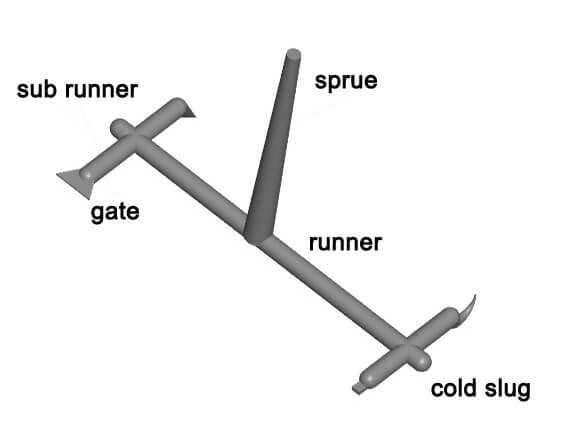
It works perfectly on cylindrical parts where the manufacturer builds the fate into the sprue where it enters a fixed tool.
Pros
- Easy to design and use for manufacture
- Allows injection of large plastic volumes quickly
- An excellent method for cylindrical or round parts to achieve concentricity
- Produces parts with lower stress and high strength
- Low costs of maintenance.
Cons
- May leave a significant mark at the contact point
- Removal of the gate has to be manual
Edge Gates
These are among the most common gates in plastic injection molding design. Their wide use is due to their effectiveness and simplicity in the process. As the name suggests, an edge gate is present on the mold’s edge.
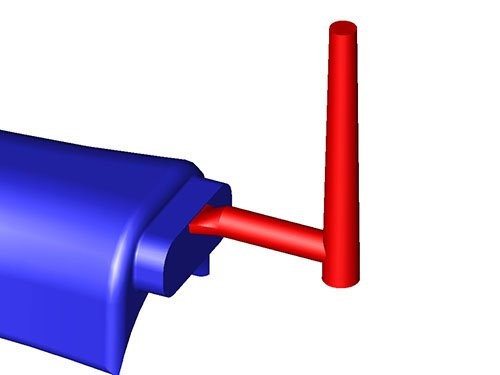
They have larger cross-sectional areas when compared to other gates. Thus, they allow the flow of more molten plastic into the cavity. Their best application is in the manufacture of flat parts.
Pros
- Simple and effective
- Relatively cheap to design and manufacture
- Enlargement is possible without the removal of mold from the operating machine
- Has a larger cross-sectional area for more plastic flow
Cons
- Witness marks and weld lines may occur with edge gate
- Degradation of plastic is possible with high injection pressures
Submarine Gates
Also known as tunnel gates or sub-gates, this injection molding gate design involves directing plastics to the cavity’s edge below the parting line.
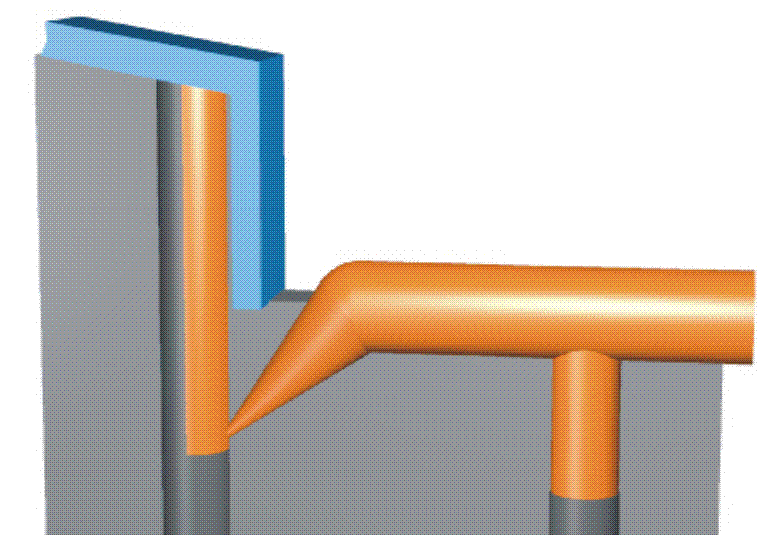
Thus, it ensures that the trimming of the gate occurs automatically. It uses a pin to shear the runner off. It reduces scars and simplifies gate removal. It is an ideal method for small parts and high cavitation molds.
Pros
- Automatic trimming or removal of the gate
- Pushes excess vent gasses out of the mold
- Reduces scars or moves them to a less significant area
Cons
- More complex to manufacture
- It can be time-consuming and expensive
Fan Gates
These types of gates are alternatives to edge gates. They come with fans that maintain consistent thickness.
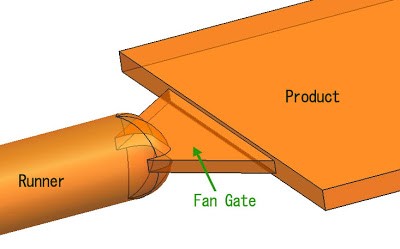
However, the fans spread out, increasing its volume over a large area. These fans are more recommended for use with polycarbonate plastics.
Pros
- An excellent choice for increasing plastic flow volumes in thin-edge parts
- Reduces the injection pressure used on a given volume of plastic
Con
- This may leave a significant mark on the part, increasing post-processed costs
How Injection Molding Gate Design Can Affect Your Part’s Quality
All gate designs in injection molding force molten plastic into the cavity or core under pressure. Therefore, they accelerate the plastic and increase the heat as it moves into the plastic. The working of gates may lead to several effects on the plastic part.
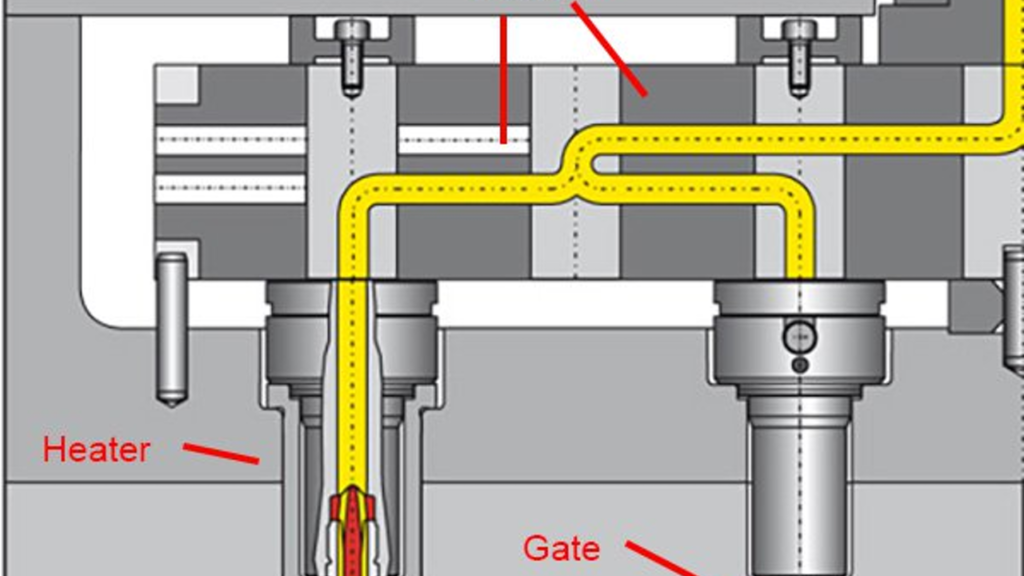
At this point, you may need to change the injection molding gate design. The most common effects include:
Jetting
A gate that’s too small results in a drop of pressure as the molten plastic moves into the cavity. As a result, it often leads to a defect called jetting. Jetting describes the spraying of the plastic into the core rather than the typical smooth flow. Such an event leads to wavy distortions that manufacturers often refer to as “worming.” To overcome this problem, a decrease in pressure is often required or an increase in gate size. Sometimes, you may need to do both.
Overheating
Friction often occurs from the high injection speed of the plastic through the gate. When the heat becomes too much, there may be a decay of resins. This decay is usually a result of destroyed molecular bonds in the plastic.
However, overly reducing or injection speed to avoid this decay may lead to other molding defects like weld lines. It may also lead to the poor mechanical strength of the final product. Moreover, a slower cycle time often equals the production of fewer parts per hour. This, in turn, increases processing costs.
In this case, you can divide the volume of the plastic resins over several different gate vestiges. That way, you can dissipate pressure, avoiding overheating in the process. You must be careful at this juncture as well. This is because multiple flow fronts often lead to gas traps and weld lines wherever the fronts meet in the cavity.
RapidDirect’s Complete Injection Molding Solutions
At RapidDirect, we offer high-class plastic injection molding services at cost-effective prices. We have over 100 different plastic resins and other materials to ensure that you get the highest quality products. With the expertise and experience of our qualified engineers, on-demand manufacturing has never been better.
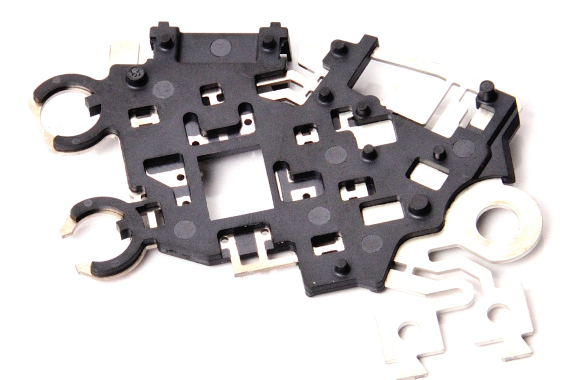
Our instant quotation platform generates quotes for you within seconds. Also, our efficient tooling ensures accelerated manufacturing cycles. Each of the tech-driven on-demand plastic manufacturing processes has its benefits, and you don’t want to miss out on it. All you need to do is upload your design file today!
Design Considerations for Injection Molding Gate
There are certain essential factors you must consider while designing parts for injection molding. You need to ask yourself many questions regarding the gate location injection molding and the gate dimension design.
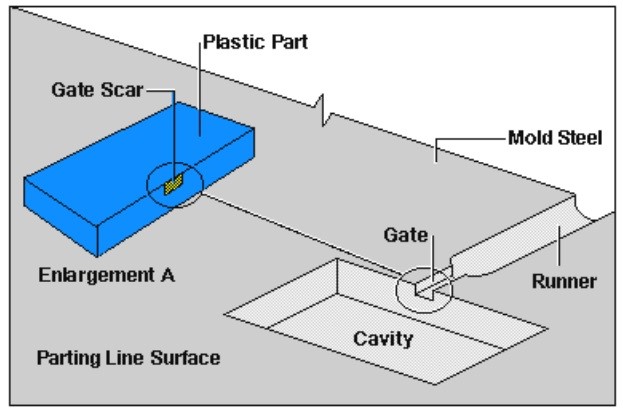
Another essential question is how to determine gate size for injection molding. Every one of these factors is critical. Consequently, they tend to affect the process and the product. The design considerations include:
Injection Molding Gate Size
The gate size must allow proper shearing whenever the mold cycles inside the machine. Gate dimensions design must allow filling the mold correctly and keeping the smallest possible runner. It must also let the molten plastic resin get to every part of the mold before hardening.
A small gate design often gives a nicer part appearance. However, it may lead to stress due to increased pressure of filling. So, the gate must not be too large or too small, just adequate for the process.
Injection Molding Gate Location
The gate location is another vital factor to consider. It can help with any issue that may arise with the gate size. When considering the gate location in injection molding, you should place the gates in the deepest cross-section. This minimizes sinking and voids and helps to provide the best plastic flow. Do not place the gate near pins, cores, or any other obstructions.
Also, gates should be the closest to the thick-walled areas for complete packing. Also, the gate should be on a mold where it won’t be affected by the runner’s distortion. It should not also affect the users’ aesthetics. You should employ gates in such a way that it reduces their sizes. It may also deal with thin edges or areas within the cavity that may act as bottlenecks for the plastic resin.
Number of Injection Molding Gates
In some cases, you may need to use more than one gate in the molding process. Using multiple gates will help with issues that may arise with the sizes and gate location injection molding. Furthermore, multiple gates deal with thin areas in the mold cavity.
Conclusion
Injection molding gate design is a critical part of the injection molding process. It is vital to get it right to ensure quality prototypes and high-end products. Variables such as gate size, location, and number are essential considerations when designing gates. The knowledge of gate design helps RapidDirect to offer top-quality injection molding services. Request a quote today!


